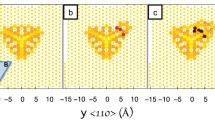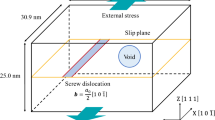Abstract
The interaction of a gliding screw dislocation with stacking fault tetrahedron (SFT) in face-centered cubic (fcc) copper (Cu) was studied using molecular dynamics simulations. Upon intersection, the screw dislocation spontaneously cross slips on the SFT face. One of the cross-slipped Shockley partials glides toward the SFT base, partially absorbing the SFT. At low applied stress, partial absorption produces a superjog, with detachment of the trailing Shockley partial via an Orowan process. This leaves a small perfect SFT and a truncated base behind, which subsequently form a sheared SFT with a pair of opposite sense ledges. At higher applied shear stress, the ledges can self-heal by gliding toward an SFT apex and transform the sheared SFT into a perfect SFT. However, complete absorption or collapse of an SFT (or sheared SFT) by a moving screw dislocation is not observed. These observations provide insights into defect-free channel formation in deformed irradiated Cu.













Similar content being viewed by others
References
M.A. Meyers K.K. Chawla: Mechanical Metallurgy: Principles and Applications, Prentice Hall 1984 528
G.V. Muller, D. Gavillet, M. Victoria J.L. Martin: Postirradiation tensile properties of Mo and Mo alloys irradiated with 600 MeV protons. J. Nucl. Mater. 212–215, 1283 1994
B.N. Singh, A. Horsewell, P. Toft D.J. Edwards: Temperature and dose dependencies of microstructure and hardness of neutron irradiated OFHC copper. J. Nucl. Mater. 224, 131 1995
A.F. Rowcliffe, S.J. Zinkle, J.F. Stubbins, D.J. Edwards D.J. Alexander: Austenitic stainless steels and high strength copper alloys for fusion components. J. Nucl. Mater. 258–263, 183 1998
M. Victoria, N. Baluc, C. Bailat, Y. Dai, M.I. Luppo, R. Schäublin B.N. Singh: The microstructure and associated tensile properties of irradiated fcc and bcc metals. J. Nucl. Mater. 276, 114 2000
Z. Yao, R. Schaublin M. Victria: Tensile properties of irradiated Cu single crystals and their temperature dependence. J. Nucl. Mater. 329–333, 1127 2004
H. Kimura R. Maddin: Lattice defects in quenched metals in Proceedings of an International Conference, edited by R. Cotterill Academic Press, New York 1965 319
D. Rodney: Atomic-scale modeling of clear band formation in FCC metals. Nucl. Instrum. Methods, 228, 100 (2005)
Y.N. Osetsky, Y. Matsukawa, R.E. Stoller S.J. Zinkle: On the features of dislocation-obstacle interaction in thin films: Large-scale atomistic simulation. Philos. Mag. Lett. 86, 511 2006
Y.N. Osetsky, D. Rodney D.J. Bacon: Atomic-scale study of dislocation-stacking fault tetrahedron interactions. Part I: Mechanisms. Philos. Mag. 86, 2295 2006
J.S. Robach, I.M. Robertson, H-J. Lee B.D. Wirth: Dynamic observations and atomistic simulations of dislocation-defect interactions in rapidly quenched copper and glod. Acta Mater. 54, 1679 2006
Y. Matsukawa, Y.N. Osetsky, R.E. Stoller S.J. Zinkle: Destruction processes of large stacking fault tetrahedral induced by direct interaction with gliding dislocations. J. Nucl. Mater. 351, 285 2006
B.N. Singh S.J. Zinkle: Defect accumulation in pure fcc metals in the transient regime: A review. J. Nucl. Mater. 206, 212 1993
Y. Dai M. Victoria: Microstructure evolution during irradiation in Microstructure Evolution During Irradiation edited by I.M. Robertson, G.S. Was, L.W. Hobbs, and T. Diaz de la Rubia Mater. Res. Soc. Symp. Proc., 439 Pittsburgh, PA 1997 319
B.D. Wirth, V.V. Bulatov T.D. la de Rubia: Dislocation-stacking fault tetrahedron interactions in Cu. J. Eng. Mater. Technol.—Trans. ASME 124, 329 2002
Y.N. Osetsky, R.E. Stoller Y. Matsukawa: Dislocation-stacking fault tetrahedron interaction: What can we learn from atomic-scale modelling. J. of Nucl. Mater. 329–333, 1228 2004
Y.N. Osetsky, R.E. Stoller, D. Rodney D.J. Bacon: Atomic-scale details of dislocation-stacking fault tetrahedral interaction. Mater. Sci. Eng., A 400–401, 370 2005
E.T. Johnson P.B. Hirsch: TInsitu straining in the HVEM of neutron-irradiated copper-crystals. Philos. Mag. 43, 157 1981
J.S. Robach, I.M. Robertson, B.D. Wirth A. Arsenlis: In-situ transmission electron microscopy observations and molecular dynamics simulations of dislocation-defect interactions in ion-irradiated copper. Philos. Mag. 83, 955 2003
Y. Matsukawa S.J. Zinkle: Dynamic observation of the collapse process of a stacking fault tetrahedron by moving dislocations. J. Nucl. Mater. 329–333, 919 2004
P. Szelestey, M. Patriarca K. Kaski: Computational study of a screw dislocation interacting with a stacking-fault tetrahedron. Model. Simul. Mater. Sci. Eng. 13, 541 2005
H-J. Lee, B.D. Wirth: (unpublished)
T.D. la de Rubia M.W. Guinan: Progress in the development of a molecular dynamics code for high-energy cascade studies. J. Nucl. Mater. 174, 151 1990
Y. Mishin, M.J. Mehl, D.A. Papaconstantopoulos, A.F. Voter J.D. Kress: Structural stability and lattice defects in copper: Ab initio, tight-binding, and embedded-atom calculations. Phys. Rev. B 63, 224106 2001
J. Hirth, J. Lothe: Theory of Dislocations Krieger Publishing Company 1992
W.M. Stobbs C.H. Sworn: Weak beam technique as applied to determination of stacking-fault energy of copper. Philos. Mag. 24, 1365 1971
J. Silcox P.B. Hirsh: Direct observations of defects in quenched gold. Philos. Mag. 4, 72 1959
D. Rodney: Molecular dynamics simulation of screw dislocation interacting with interstitial frank loops in a model FCC crystal. Acta Mater. 52, 607 2004
C. Kittel: Introduction to Solid State Physics, 7th ed. John Wiley & Sons 90
A.S. Clarke H. Jónsson: Structural changes accompanying densification of random hard-sphere packings. Phys. Rev. E 47, 3975 1993
D. Kuhlmann-Wilsdorf: The growth and annealing of stacking fault tetrahedral. Acta Metall. 13, 257 1965
L. Saintoyant, H-J. Lee B.D. Wirth: Molecular dynamics study of the interactions between dislocation and truncated staking fault tetrahedron in Cu. J. Nucl. Mater. 361, 206 2007
Acknowledgments
The authors thank Professors David Rodney (INPG) and Ian Robertson (UIUC), and Dr. Y. Osetsky and Dr. Y. Matsukawa (ORNL) for many helpful discussions. We gratefully acknowledge the financial support of the National Science Foundation under Contract No. NSF DMR 0244562, Department of Energy, the Office of Fusion Energy Sciences under Grant No. DE-FG02-04GR54750, and the Office of Nuclear Energy, Science and Technology (NEER program) under Contract No. DE-FG07-041D14594.
Author information
Authors and Affiliations
Corresponding author
Rights and permissions
About this article
Cite this article
Lee, HJ., Shim, JH. & Wirth, B.D. Molecular dynamics simulation of screw dislocation interaction with stacking fault tetrahedron in face-centered cubic Cu. Journal of Materials Research 22, 2758–2769 (2007). https://doi.org/10.1557/JMR.2007.0345
Received:
Accepted:
Published:
Issue Date:
DOI: https://doi.org/10.1557/JMR.2007.0345




